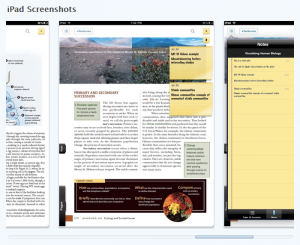Weber Media Partners | Impressions Through Media
Conversational Marketing in the Age of Social Media
- Home
- About This Blog
- Contact
- Sitemap
How Many Flavors Do You Have? Harnessing the SEO impact of Social Media
Author: Catherine Weber23 Nov
Last week I presented to the SEMNE professional organization in Rocky Hill Connecticut to a room full of search engine optimization experts. In surveying the crowd in advance of delivering this presentation, many attendees wanted to know how social media can help build a website’s inbound links. To explain how this works, I used the following analogy.
How many cereal boxes do you have?
We have all noticed the remarkable variety of cereal types in the grocery store. An entire aisle has been dedicated to only a few cereal companies, who each have dozens of brands on the shelf. Cereal companies provide this varieties to increase the the amount of shelf space the own, and the likelihood of sell at least one box to each shopper. The aisle is a finite space, and they want as much of that space as possible. It is this same philosophy the SEO expert should consider in leveraging social media. Every employee profile created on Linkedin, the Facebook, Twitter, YouTube, Slideshare accounts, and blog post that mentions the brand, give the company one more item in Google search results. So, like creating another brand of cereal for the aisle, each property is an opportunity to get your brand in front of your customer or prospect. These properties also build an inbound linking program to help raise the quality of the website overall.
Create a Sustainable Content Strategy
It is important to note that setting up these properties is only the beginning. You must have a content strategy that considers your audience and what they are interested in. Your content should be helpful and interesting, not advertising stuffed with key words. This strategy should be sustainable, and relevant to your audience. You should monitor what people are commenting on and sharing, and tweak your content to reflect what you are continually learning from your audience.
Below are my slides from the presentation. Soon I will post the talk itself, with the slides incorporated. Let me know what you think.
- 3 Comments
- Filed under: social media marketing
Businesses Benefit from Strategic Social Media Programs
Author: Catherine Weber3 Nov
 While social networking began as a consumer activity, it has become a crucial component of most business marketing strategies as it allows companies to reach highly targeted audiences with custom messaging to build brand awareness and establish a relationship with the customer who now expect companies to be reachable and accountable.
While social networking began as a consumer activity, it has become a crucial component of most business marketing strategies as it allows companies to reach highly targeted audiences with custom messaging to build brand awareness and establish a relationship with the customer who now expect companies to be reachable and accountable.
Business Benefits
Businesses are now regularly using tools such as Twitter, YouTube, Facebook and LinkedIn for hiring, customer support, product development, brand recognition, and, of course, client acquisition and retention. Social media has another benefit: the cost of acquiring customers is significantly lower than placing ads, and creates a lasting relationship.
The benefits of a quality social media marketing program include:
- Transparent, authentic feedback from your audience
- Integrates well with conventional marketing programs
- Reach highly-targeted audiences
- Improves search engines positioning
- Lower cost than advertising
- More long term and wider impact than conventional public relations
Listen first, Act second
Buyers look to objective internet sources to compare business products and services including existing customers who are more than willing to share their experience with these products. Companies can’t control the chatter, but they can learn what customers want.
Brands such as Comcast have made major strides in customer service by listening on Twitter. When their brand is mentioned, they know. When someone has a problem, they help them within minutes. They follow the first rule of social media: listen first, act second. Maintaining a regular monitoring program helps to understand customer sentiment and how it changes as you implement online programs.
Defining Success
Measuring the success of a social media campaign is possible only if you define your targets in advance. Whether they include increased traffic, website conversions or leads, you must have clear targets for successful campaigns, at short-term and long-term time intervals. A few examples of what success might look like include:
- Gaining a better understanding of your customers
- Increase brand exposure in ways which were not possible before
- Reducing costs for achieving the same targets using other marketing tactics
- Increase sales and conversions
Some great resources to compliment this blog post:
Social Commerce, Social Media Today, November 2, 2010
Content for People, Not Robots, Impressions Through Media, September 18, 2010
- 5 Comments
- Filed under: business, social influence, social media marketing, social media monitoring, web 2.0
Speaking of Core Values
Author: Catherine Weber25 Oct
 Last month, I presented to FastTRack MBA students at Babson College in the Managing Growing Business class about Weber Media Partners’ history, growth and core values. In the five years that I have presented to this class each semester, rarely does any other presenter whom I share the podium talk about their organizational values. Most talk about profit and venture funding and the mechanics of the business. While I can’t say that values alone will make you profitable, and that having no values will cause you to fail, I can say that they matter to our company.
Last month, I presented to FastTRack MBA students at Babson College in the Managing Growing Business class about Weber Media Partners’ history, growth and core values. In the five years that I have presented to this class each semester, rarely does any other presenter whom I share the podium talk about their organizational values. Most talk about profit and venture funding and the mechanics of the business. While I can’t say that values alone will make you profitable, and that having no values will cause you to fail, I can say that they matter to our company.
A few weeks ago, I attended a presentation by Tony Hsieh, CEO of Zappos, who spoke at Bentley University for American Marketing Association, Boston Chapter as part of his Delivering Happiness book tour. Tony attributes his company success to developing and staying true to core values. His slides and audio of his talk (turn your volume up for this) will give you some insight into why Amazon bought Zappos for 1.2 billion dollars in 2009.
The values, relationships and passion he talked about resonated with our business values at Weber Media Partners. They drive how you communicate with your audience, the business practices you use and your every day communications with your team. I would love to hear from you about how your company’s core values guide your success.
- 3 Comments
- Filed under: business growth, core values
Boston Harbor Islands National Park Area’s new Trip Planner
Author: Catherine Weber19 Oct
 Weber Media Partners has been working with Boston Harbor Islands National Park Area for nearly 10 years. We have had the pleasure to work with some of the hardest working professional National Park Service staff, who care tremendously about natural resources in this country, and in particular, about the natural history and American history that makes up the many islands in Boston Harbor. When we had the opportunity to work with them on their new website, we were excited, but also knew that it was a highly visible project, with many stakeholders to serve.
Weber Media Partners has been working with Boston Harbor Islands National Park Area for nearly 10 years. We have had the pleasure to work with some of the hardest working professional National Park Service staff, who care tremendously about natural resources in this country, and in particular, about the natural history and American history that makes up the many islands in Boston Harbor. When we had the opportunity to work with them on their new website, we were excited, but also knew that it was a highly visible project, with many stakeholders to serve.
We had an amazing team of writers, developers, project managers and designers, all who care passionately for the outcome. We created a site that provides intuitive trip planning for all types of visitors. See the full case study for more details.
We are pleased to say that our hard work has paid off for Boston Harbor Islands, where visitation is up to an all-time high. Superintentent Bruce Jacobson writes in his weekly email:
“We had more visitors to the islands this past spring, summer, and fall season than any other year. More than 100,000 passengers rode the park ferry. Double that number visited locales accessible by car.
Thank you to all who have worked so hard making this season one of the best yet!”
To add to this, Weber Media Partners has been selected as a finalist for a much acclaimed MITX award for this project in the Environmental Consciousness category. We are thrilled to be recognized for our work and look forward to the ceremony on November 18th.
- 1 Comment
- Filed under: nonprofit, websites
Content for People, Not Robots (well, mostly)
Author: Catherine Weber18 Sep
 Dianna Huff, DH Communications, presented content marketing at the SEMNE meeting on Wednesday. Her presentation focused on why SEO firms should think like marketers and helping clients create content. See her presentation here.
Dianna Huff, DH Communications, presented content marketing at the SEMNE meeting on Wednesday. Her presentation focused on why SEO firms should think like marketers and helping clients create content. See her presentation here.
I was excited to hear another marketing consultant expound on this important issue. The challenge for any business, large or small, with making social media succcessful and keeping it on track is to have a content strategy and have a regular stream of valuable content that speaks to your audience. Some SEO practitioners may be optimizing content, but not actually helping them produce it, when of course, SEO is not just about optimized content, but the continued publishing of optimized content that will actually be useful to your audience. It’s not just about the robots that index your website, it’s about the actual PEOPLE who read it!
We at Weber Media Partners recognized this as the main challenge for SMBs to contend with when they consider doing a social media work- from blogs to twitter to Facebook, if you want to stay in front of you customer, don’t annoy them and don’t be invisible- be helpful and interesting. Companies have the same issues when launching SEO and PPC campaigns. So, having said this, Dianna gave some great tips, which I agree whole heartedly with: Read the rest of this entry »
- 3 Comments
- Filed under: blogging, content creation, ebooks, SEO, social media marketing, social media monitoring, viral video
Best Back To School Campaigns, Part III: Bookstore Alternatives
Author: Jaclyn Mosher1 Sep
Part III of our Best of Back to School marketing campaigns of 2010 dives into the changing world of college textbooks. In recent years, numerous companies have sprung up offering alternatives to the notoriously expensive college bookstore. This year, I was particularly impressive by two such companies – Coursesmart and Chegg.
Through its sleek, easy-to-use website, Coursesmart offers an ever-growing selection of “e-textbooks” – electronic versions of the traditional print texts that can be read on desktops, laptops, iPads and even iPhones. Coursesmart’s e-textbooks give the reader the ability to highlight sections, take notes in the margins, print selected pages and cut and paste selections. Now there is no need to carry around tons of heavy books – you can keep them all on our laptop, read for easy access with just one click.
 I was particularly impressed by Coursesmart’s synergy with Apple products. Being able to access textbooks from an iPhone is the ultimate in transportable texts. Furthermore, the iPad opens the door to more interactive and impactful textbooks. (See image above for an example of a Coursesmart text viewed on a iPad.) The Wall Street Journal discussed the iPad and Coursesmart’s innovative e-texts in a recent article, stating that the new device makes book publishers “eager to exploit its color, video, and touch-screen capabilities.” I, for one, would love to test drive this exciting new technology.
I was particularly impressed by Coursesmart’s synergy with Apple products. Being able to access textbooks from an iPhone is the ultimate in transportable texts. Furthermore, the iPad opens the door to more interactive and impactful textbooks. (See image above for an example of a Coursesmart text viewed on a iPad.) The Wall Street Journal discussed the iPad and Coursesmart’s innovative e-texts in a recent article, stating that the new device makes book publishers “eager to exploit its color, video, and touch-screen capabilities.” I, for one, would love to test drive this exciting new technology.
Of course, this new technology comes with a big price tag. Coursesmart’s e-textbooks, while less expensive than print versions, can still run in the $100 range. And then there’s the iPad, priced at $499 – a very pricey item to pile on top of an already expensive back to school season. Another textbook innovator, Chegg, combines new and old technology to offer a more affordable alternative.
Read the rest of this entry »
- 0 Comments
- Filed under: books, e-texts, facebook, social media marketing
Best Back To School Campaigns, Part II: Target’s Social Checklist
Author: Jaclyn Mosher27 Aug
On Wednesday, I kicked off my series on the best Back to School marketing campaigns of 2010. I sought out campaigns that are innovative, fun and helpful, both to the shopper and the community at large. In Part II of the series, I will highlight Target’s innovative and extremely useful “Roomates” Facebook app.
Target is a popular destination for college students stocking up on dorm necessities. To help ensure these coeds get everything they need, Target has developed . The checklist has three options (“buy,” “have” and “pass”), and includes links to purchase specific products on Target.com.
The best part about this campaign, however, is the roommates option. This part of the app allows students to share their list with their roommate(s), helping ensure that one suite will not wind up with four vacuums and only one lamp. The app also features messaging, calendars, and even a bill splitter – definitely something I wish I had in college.
Once the checklist is complete, students can select the print option and bring the list along on their shopping trip. The checklist is even available on Target.com in a more traditional PDF format. All in all, this campaign is a helpful tool for college students, as well as an ingenious way to show off the megastore’s seemingly innumerable product offerings.
Stop by our blog on Monday for the conclusion of this series, in which I discuss two innovative and cost-effective alternatives to the traditional college bookstore.
- 0 Comments
- Filed under: facebook, social media marketing
Best Back To School Campaigns, Part I: Staples Makes a Difference
Author: Jaclyn Mosher25 Aug
Two weeks ago, a milestone was reached: I received my first school-related e-mail message. It opened with a jolly greeting from my professor, and moved quickly to talk of future assignments and course requirements. That’s when it hit me – I need to get ready for back to school!
As a grad student, I’ve done the Back to School ritual more times then I’d care to count. So, to liven up the hunt this year, I’ve added an additional item to my usual list of notebooks, highlighters and (of course) new shoes – find my favorite Back to School marketing campaigns. I sought out campaigns that are innovative, fun and helpful, both to the shopper and the community at large. A lucky few made it to the top of the class, and I will detail those campaigns in a series of three posts. Today, I will profile Staples’ philanthropy.
 Students and parents browsing the aisles (or web site pages) of this office superstore for back to school necessities can do more than just buy – they can give back, too. For the third year in a row, Staples has partnered with teen-centric non-profit DoSomething.org to collect school supplies for children in need. Donation bins have been set up in Staples retail locations across the country, and school supplies of all kinds will be collected now through September 18th.
Students and parents browsing the aisles (or web site pages) of this office superstore for back to school necessities can do more than just buy – they can give back, too. For the third year in a row, Staples has partnered with teen-centric non-profit DoSomething.org to collect school supplies for children in need. Donation bins have been set up in Staples retail locations across the country, and school supplies of all kinds will be collected now through September 18th.
This year, Staples used and a celeb-filled online game to help students get involved. Teen can vote to join their favorite celebrity’s “pack,” and in the process donate $1 to the cause. Donations are also accepted via text message.
All in all, I loved Staples’ idea and its execution. These simple donations are a great way to teach everyone from preschoolers to high schoolers the importance of generosity and kindness towards those who are less fortunate. Furthermore, through their Do Something 101 microsite, they provide helpful tips that help students run their own school supply drives – the lesson being that teens can really “do something” big to help their communities.
Judging by the 28,000 Facebook fans and thousands of votes on the contest page, this event is a proving to be a success. Even Staples’ archrival Dunder Mifflin is getting in on the action! With that endorsement secured, I now know where I’ll be purchasing my paper…
I hope you have enjoyed this first installment of my survey of the best of Back to School. Be sure to visit our blog soon to see who else made the list!
- 1 Comment
- Filed under: facebook, social media marketing, web 2.0
Learning Loyalty from the Grateful Dead
Author: Catherine Weber23 Aug
 In 2008, David Meerman Scott drew comparisons between social marketing and the Grateful Dead at the the first Inbound Marketing Conference in Massachusetts. Having seen dozens of Dead shows, my first in 1982, I immediately understood what he was talking about.
In 2008, David Meerman Scott drew comparisons between social marketing and the Grateful Dead at the the first Inbound Marketing Conference in Massachusetts. Having seen dozens of Dead shows, my first in 1982, I immediately understood what he was talking about.
This band did everything differently– they produced only 13 albums over 30 years but instead toured constantly, doing more than 2300 shows. They played different songs every night from their catalog of 500 and supported the fans need for live shows by letting them record from a special section in the audience. Their brand lives on more than 15 years after Jerry Garcia’s death, and new fans are discovering them even now.
So, when I heard that David and Brian Halligan of Hubspot had written “Marketing Lessons from the Grateful Dead: What Every Business Can Learn from the Most Iconic Band in History”, I knew I needed to review it here. It covers how the Dead did the marketing basics differently: Their unique brand, message and offering, their fans(customers), and finally, their business model and operations. It’s a perfect guide for CEOs and marketers to learn to think differently and create a break through brand.
Read the rest of this entry »
- 7 Comments
- Filed under: books, social media marketing, social media marketing, web 2.0
Do you like what I like? The power of social influence.
Author: Catherine Weber8 Aug
Twenty years ago, our friend Dan did meticulous research on lawnmowers, comparing price and quality, reading Consumer Reports, and talking to various salesmen, asking questions at local stores. Once he decided which brand and model to buy, we piggybacked on his research and bought the same one because we knew he did a thorough evaluation.
While influence is nothing new, the many ways we’re influenced is, in more and more ways. If you consider all of the consumer buying decisions we make: where we shop and dine out, which movies we see and what music we listen to, we have always made decisions with influence from our family, our friends, and, even perfect strangers.
 Now, in addition to in-person influence, we are often influenced by a virtual community made up of people that we know, and their friends, many who post their opinions on , by liking a page, or on Amazon, by reviewing a product, or on Yelp, by reviewing a restaurant or local business. (Yelp, by the way, got in trouble with site users for manipulating reviews in favor of advertisers and has changed their policy based on widespread negative feedback.)
Now, in addition to in-person influence, we are often influenced by a virtual community made up of people that we know, and their friends, many who post their opinions on , by liking a page, or on Amazon, by reviewing a product, or on Yelp, by reviewing a restaurant or local business. (Yelp, by the way, got in trouble with site users for manipulating reviews in favor of advertisers and has changed their policy based on widespread negative feedback.)
![]() That’s why has been making it easy for companies to incorporate the Like widget on their websites and blogs. Everything you “like” is cataloged for all of your Facebook friends to see.
That’s why has been making it easy for companies to incorporate the Like widget on their websites and blogs. Everything you “like” is cataloged for all of your Facebook friends to see.
- 4 Comments
- Filed under: social influence, social media marketing
- Subscribe To Feed (RSS)
- Comments (RSS)
- Subscribe via Email





Recent Comments
Do businesses need both?